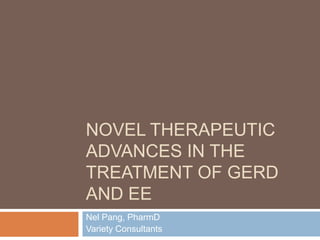
Novel Therapeutic Advances In The Treatment Of Gerd
- 1. Novel Therapeutic Advances in the Treatment of GERD and EE Nel Pang, PharmD Variety Consultants
- 2. Agenda Pathophysiology Current Treatment Guidelines Dexlansoprazole and FDA Clinical Trials Healing of Erosive Esophagitis Maintenance of Healed Erosive Esophagitis Symptomatic Non-Erosive GERD Questions and Answers
- 3. Pathophysiology GERD affects nearly 19 million Americans and is often characterized by frequent and persistent heartburn that occurs two or more days a week despite treatment and diet changes. GERD can affect both men and women, and symptoms are often triggered by certain foods, stress or pressure on the stomach. GERD is a chronic condition commonly known as acid reflux disease. GERD can occur when the valve at the lower end of the esophagus, called the lower esophageal sphincter (LES), does not work properly. This valve opens to allow food and liquids to enter the stomach and closes to keep acid and food in the stomach. When the LES does not close as tightly as it should, or relaxes too often, it can cause stomach contents to get into the esophagus repeatedly. The stomach is better equipped to handle acid than the esophagus. If the esophagus is continually exposed to stomach contents, damage to the lining of the esophagus such as breaks or lesions can occur, a condition known as erosive esophagitis (EE).
- 5. Current Treatment Guidelines Based on AGA Medical Position Statement of the Management of Gastroesophageal Reflux Disease Grade A recommendations, which are "strongly recommended based on good evidence that it improves important health outcomes," according to the AGA Institute, include:
- 6. Current Treatment Guidelines I. Antisecretory drugs for the treatment of patients with esophageal GERD syndromes (healing esophagitis, symptomatic relief and maintaining healing of esophagitis). In these uses, proton pump inhibitors (PPIs) are more effective than histamine receptor antagonists (H2RAs), which are more effective than placebo. II. Long-term use of PPIs for the treatment of patients with esophagitis once they have proven clinically effective. Long-term therapy should be titrated down to the lowest effective dose based on symptom control.
- 7. Current Treatment Guidelines III. When antireflux surgery and PPI therapy are judged to offer similar effectiveness in a patient with an esophageal GERD syndrome, PPI therapy should be recommended as initial therapy because of superior safety. IV. When a patient with an esophageal GERD syndrome is responsive to, but intolerant of, acid suppressive therapy, antireflux surgery should be recommended as an alternative. V. Twice-daily PPI therapy as an empirical trial for patients with suspected reflux chest pain syndrome after a cardiac etiology has been carefully considered.
- 8. Dexlansoprazole (Kapidex) KAPIDEX combines an enantiomer of lansoprazole with a Dual Delayed ReleaseTM (DDR) formulation designed to provide two separate releases of medication. KAPIDEX is a proton pump inhibitor (PPI) indicated for: Healing of all grades of erosive esophagitis (EE). Maintaining healing of EE. Treating heartburn associated with non-erosive gastroesophageal reflux disease (GERD).
- 9. Dexlansoprazole (Kapidex) Dosage and Administration *Controlled Studies did not extend beyond 6 months
- 10. Dexlansoprazole (Kapidex) Metabolism Hepatic – 2C19, 3A4 Drug-Drug Interactions Minimal clinically significant interactions Ph sensitive drugs Space Doses Pregnancy Category B No adequate studies in pregnant women
- 11. Dexlansoprazole and Clinical Trials Healing of Erosive Esophagitis (N=4092) Treatment Arms KAPIDEX 60 mg daily KAPIDEX 90 mg daily lansoprazole 30 mg daily Exclusions H pylori positive Barrett’s Esophagus Definite dysplastic changes
- 12. Dexlansoprazole and Clinical Trials Healing of Erosive Esophagitis (N=4092) Endpoint: Kapadix non-inferior to Lansoprazole
- 13. Dexlansoprazole and Clinical Trials Maintenance of Healed Erosive Esophagitis (N=445) Treatment Arms KAPIDEX 30 mg daily KAPIDEX 60 mg daily Placebo
- 14. Dexlansoprazole and Clinical Trials Maintenance of Healed Erosive Esophagitis (N=445) Endpoint: Maintenance of healing and symptom resolution over a six-month period
- 15. Dexlansoprazole and Clinical Trials Symptomatic Non-Erosive GERD (N=947) Treatment Arms KAPIDEX 30 mg daily KAPIDEX 60 mg daily Placebo Inclusion Criteria heartburn as their primary symptom heartburn history of heartburn for 6 months or longer had heartburn on at least 4 of 7 days immediately prior to randomization no esophageal erosions as confirmed by endoscopy
- 16. Dexlansoprazole and Clinical Trials Symptomatic Non-Erosive GERD (N=947) Endpoint: Percent of days with heartburn-free 24-hour periods
- 17. Clinical Pearls GERD affects nearly 19 million Americans. Guidelines recommend PPI over H2 Antagonists, using PPIs first over surgical options, and using the lowest possible PPI dose. KAPIDEX contains two types of enteric-coated granules resulting in a concentration-time profile with two distinct peaks: the first peak occurs one to two hours after administration, followed by a second peak within four to five hours. KAPIDEX, with its DDR formulation, has demonstrated efficacy in non erosive GERD, treating EE, and maintaining EE healing.
- 18. Questions and Discussion Evaluation and Feedback Follow Up